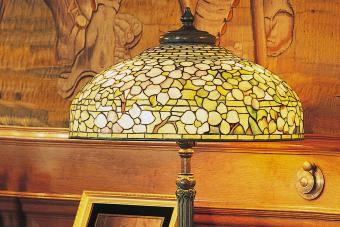Identifying Antique Silverware

Identifying antique silverware patterns is tricky. Often the silver has been passed down for generations and the name of the design, the manufacturer, and the history have been lost.
Identifying Antique Silverware Patterns
Try to find a maker’s mark on your silver. This mark is generally located on the underside of the handle. If the silver is tarnished you may need to clean it to find the marks. This pattern is Daffodil by Manchester, circa 1900. This beautiful Art Noveau pattern is indicative of the flowing lines that were popular in this era.
Towle Georgian Pattern

The Georgian pattern by Towle was created in 1898. It is an intricate design pattern with an elegant look. The handle is created to look like a Greek column with curves capitals on the top edge. Notice the rose on the top of the handle as well as partway down, and the rose motif added again, where the handle meets the body of the fork.
Shown are a butter knife and a fork.
Adolphus Mt. Vernon Pattern

Mt. Vernon by Adolphus is an interesting pattern that shows some of the transition from Victorian to Colonial style. Created in 1900, this pattern has a floral top and a beaded edge. While other patterns from this time period might be simpler and more colonial in look, Mt. Vernon gives one last nod to the Victorian love of decoration while embracing the new love of all things Early American.
Shown are a coffee spoon and a chocolate muddler.
Durgin New Art Pattern

New Art by Durgin was created at the height of Edwardian style in 1899. The Art Noveau influence is very apparent in these pieces with their graceful, almost moving forms. Notice that the braided stems of the lilies form the handle, while the floral design is carried lushly into the body of the piece. There is a smooth oval area left at the top for monogramming.
The second image is an ice spoon and the third image is a beautifully done tomato server.
Whiting Mandarin Pattern

Whiting created the Mandarin pattern in 1917. This pattern transitions from the flowing lines of Art Noveau to the graphic perfection of Art Deco. There are still some of the graceful, curving elements of the prior style but geometric design has found a place in this pattern. The center motif on the handle is classic Arts and Crafts.
The combination of these elements gives this pattern a style that is almost oriental in feel by incorporating several artistic expression in one. This silver would have looked just right on a Roycroft table or in a Greene and Greene bungalow. Pictured are a pate knife and a horseradish scoop.
International Madrid Pattern

International Silver’s Madrid pattern was released in 1927 at the height of Art Deco style. It is a simple and elegant pattern with an etched edge. A raised silver thread outlines the handle in classic Art Deco elegance.
Frank Whiting George III Pattern

George III is a late Victorian design by Frank Whiting. Released in 1891 it is lavished with decorative elements that were favorites in Victorian design. Acanthus leaves, shells, claws and monograms all find their place in this pattern. Identifying antique silverware patterns is often a matter of noticing the small design details. They are more often than not good indicators of the era in which the items were released.
Shown are a fish fork and a mustard ladle.
Reed and Barton Majestic Pattern

Reed and Barton's Majestic Pattern was released in 1894. It carried a lot of the Victorian design elements but was done in a much simpler manner than the George III pattern in the previous image. The carved lines on the handle indicate the Greek columns that were coming into vogue at this time as Victorians began to embrace Colonial design. Acanthus leaves gracefully decorate the edges.
Shown are a sugar spoon with a shell designed bowl and a fish knife.
Sign up for our newsletter featuring all the latest stories and products we love.
Gorham Decor Pattern

The Gorham Décor pattern was released in the post war boom of the mid-century. In 1953 women were enjoying a new level of entertaining in suburbia with cocktail parties, luncheons, and formal dinners. It was a similar society to the very socially aware Victorians.
This pattern has all of the grandeur and curves that would make a Victorian happy. Décor is an unusually fussy pattern for the 1950s; most homemakers bought silver with straight lines and little decoration to coordinate with the sleek lines of their atomic age homes.Shown are a salad fork and a butter knife.
Alvin Bridal Rose Pattern

The Bridal Rose pattern was released by Alvin in 1903. It is a sweet and feminine design with many roses in the pattern. Shown are a sugar spoon and a nut scoop.
LoveToKnow wishes to thank Antique Cupboard for supplying the images used in this slideshow. Antique Cupboard has images of hundreds of different silver patterns and can help you identify your heirlooms.There is nothing as elegant as a table set with heirloom silver and antique crystal. Once you identify your pattern you can work on adding to or replacing the pieces for an elegant heirloom that spans generations.







